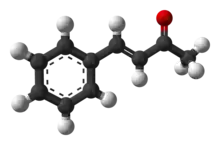 | |
 | |
| Names | |
|---|---|
| Preferred IUPAC name
(3E)-4-Phenylbut-3-en-2-one | |
| Other names
Benzalacetone Benzylideneacetone Methyl styryl ketone Benzylidene acetone | |
| Identifiers | |
3D model (JSmol) |
|
| ChEBI | |
| ChEMBL | |
| ChemSpider | |
| ECHA InfoCard | 100.015.989 |
| EC Number |
|
PubChem CID |
|
| RTECS number |
|
| UNII |
|
CompTox Dashboard (EPA) |
|
| |
| |
| Properties | |
| C10H10O | |
| Molar mass | 146.19 g/mol |
| Appearance | pale yellow solid |
| Density | 1.008 g/cm3 |
| Melting point | 39 to 42 °C (102 to 108 °F; 312 to 315 K) |
| Boiling point | 260 to 262 °C (500 to 504 °F; 533 to 535 K) |
| 1.3 g/L | |
| Solubility in other solvents | nonpolar solvents |
| Hazards | |
| Occupational safety and health (OHS/OSH): | |
Main hazards |
irritant |
| GHS labelling: | |
 | |
| Warning | |
| H315, H317, H319, H335 | |
| P261, P264, P271, P272, P280, P302+P352, P304+P340, P305+P351+P338, P312, P321, P332+P313, P333+P313, P337+P313, P362, P363, P403+P233, P405, P501 | |
| Flash point | 116 °C (241 °F; 389 K) |
| Related compounds | |
Related compounds |
Dibenzylideneacetone cinnamaldehyde |
Except where otherwise noted, data are given for materials in their standard state (at 25 °C [77 °F], 100 kPa).
Infobox references | |
Benzylideneacetone is the organic compound described by the formula C6H5CH=CHC(O)CH3. Although both cis- and trans-isomers are possible for the α,β-unsaturated ketone, only the trans isomer is observed. Its original preparation demonstrated the scope of condensation reactions to construct new, complex organic compounds.[1] Benzylideneacetone is used as a flavouring ingredient in food and perfumes.[2]
Preparation
Benzylideneacetone can be efficiently prepared by the base-induced condensation of acetone and benzaldehyde:[3]
- CH3C(O)CH3 + C6H5CHO → C6H5CH=CHC(O)CH3 + H2O
However, the benzylideneacetone formed via this reaction can undergo another Claisen-Schmidt condensation with another molecule of benzaldehyde to form dibenzylideneacetone. Because relatively weak bases such as NaOH make very little of the enolate ion at equilibrium, there is still a lot of unreacted base left in the reaction mixture, which can go on and remove protons from the alpha carbon of benzylideneacetone, allowing it to undergo another Claisen-Schmidt condensation and make dibenzylideneacetone.[4]
If, on the other hand, lithium diisopropylamide (LDA) is used as the base, all of the acetone will deprotonated, making enolate ion quantitatively. Therefore, a more efficient, but more expense way to make benzylideneacetone is to combine equimolar amounts of LDA (in THF), acetone, and benzaldehyde.[5]
Reactions
As with most methyl ketones, benzylideneacetone is moderately acidic at the alpha position, and it can be readily deprotonated to form the corresponding enolate[6]

The compound undergoes the reactions expected for its collection of functional groups: e.g., the double bond adds bromine, the heterodiene adds electron-rich alkenes in Diels-Alder reactions to give dihydropyrans, the methyl group undergoes further condensation with benzaldehyde to give dibenzylideneacetone, and the carbonyl forms hydrazones. It reacts with Fe2(CO)9 to give (benzylideneacetone)Fe(CO)3, a reagent for transferring the Fe(CO)3 unit to other organic substrates.[7]
- Hydrogenation of benzylideneacetone results in a preparation of benzylacetone.
- The reaction of 4-Hydroxycoumarin with this compound yields Warfarin.
References
- ↑ Claisen, L. "Über die Einwirkung von Aceton auf Furfural und auf Benzaldehyd bei Gegenwart von Alkalilauge" Berichte der deutschen chemischen Gesellschaft 1881, volume 14, p 2468-2471.
- ↑ Opdyke, D. L. J. (2013). Monographs on Fragrance Raw Materials: A Collection of Monographs Originally Appearing in Food and Cosmetics Toxicology. Elsevier. p. 135. ISBN 9781483147970.
- ↑ Drake, N. L.; Allen, Jr. P. "Benzalacetone". Organic Syntheses. 3: 17. doi:10.15227/orgsyn.003.0017.
- ↑ Moya-Barrios, R. CHEM 2402 Lab Manual, Winter 2016. Dalhousie University, Department of Chemistry
- ↑ Bruice, Paula Yurkanis. Organic Chemistry, 7th Edition. Pearson Education, 2014. ISBN 0-321-80322-1
- ↑ Danheiser, R. L.; Miller, R. F.; Brisbois, R. G. (1990). "Detrifluoroacetylative Diazo Group Transfer: (E)-1-Diazo-4-phenyl-3-buten-2-one". Organic Syntheses. 73: 134.; Collective Volume, vol. 9, p. 197
- ↑ Knölker, H.-J. "(η4-Benzylideneacetone)tricarbonyliron" in Encyclopedia of Reagents for Organic Synthesis (Ed: L. Paquette) 2004, J. Wiley & Sons, New York. Onlinedoi:10.1002/047084289X.rb058.